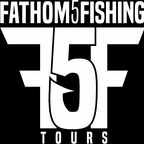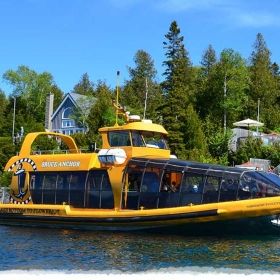Wildlife on the Bruce
Wildlife of the Bruce Peninsula
The Bruce Peninsula is home to many creatures. Bears, lynx, red squirrels, fishers, snakes, porcupines, otters - you find all these and more on the Bruce Peninsula.
Some commonly seen wildlife on the Bruce also includes chipmunk, raccoon, snowshoe hare, skunk, white-tailed deer, snakes, frogs, turtles, and eagles.
The Northern Bruce Peninsula contains significant amounts of uninterrupted forest - which makes a great ecosystem to enable the black bear, fisher, long-eared bats, northern flying squirrel, fox, martin, Massasauga rattlesnake, red-shouldered hawk, barred owl, hermit thrush, black-throated blue warbler, scarlet tanager and yellow-spotted salamander to make a home here.
Caves and crevices in the barren cliff face provide homes for ravens, turkey vultures, swallows and bats.
Black bears are also an inhabitant of the Bruce Peninsula. Black bears are smaller than their grizzly and polar cousins weighing anywhere from 100 to over 250 kilograms. They eat literally anything that is available. It is a problem when visitors and residents feed the bears - as they then get dependent on human interaction - and then become a menace. We have a saying here on the Bruce - "IF YOU FEED A BEAR - YOU KILL HIM".
The Eastern Massassauga rattlesnake, now an endangered species, was once found throughout southern Ontario. They are venomous, but avoid encounters with humans and rarely present a danger.
Other species include garter, ring-necked, De Kay’s, ribbon, smooth green, red-bellied, milk, and water snakes
KNOWbefore you go
The Bruce Peninsula has a small population of bears and other creatures. We need to respect these creatures in order to save their lives.
- Do Not Feed any wild animal
- Do Not leave garbage out anywhere.
- Use a bear-proof garbage container where ever can
- If renting a cottage - please do not ever leave your garbage outside. If the cottage has a bear-proof garbage bin, you can place your garbage in there, otherwise, take a drive to the local landfill
- No matter how cute that fox is - do not feed it
- Follow the rules and guidelines for back bush camping
- If feeding birds, only leave enough food for the day and bring in the feeders at night
- Do not speed. There are deer, raccoons, minks, turkeys, eagles bear and domestic animals like dogs, cats and cows in the area.
- Give the wildlife space - if you are taking photos, do so from a safe distance
- Do not kill any snakes. Especially a rattlesnake. Doing so is a crime and you can be fined. They are more fearful of you then you re of them
- Wear appropriate foot gear and walk on the trails. Be cautious
ads

Eastern Massasauga Rattlesnake
The Eastern Massasauga Rattlesnake is a rare species, who have received a bad name. People live in fear of these creatures, and because of fear - the rattlesnakes' lives are in danger. They are poisonous, but to my knowledge - they do not attack. They fear humans and will make haste if they hear a human near. They give off a loud rattle to let us know they are about, and this should be enough of a warning for us to take care of. They do not like to attack - and they are hesitant to bite you and release their venom.
The Eastern Massasauga rattlesnake (Sistrurus catenatus catenatus) is the only venomous snake in Ontario. It is characterized by the presence of a heat-sensitive pit between the eye and the nostril, a segmented rattle at the tip of the tail, a vertical eye pupil, and keeled scales. The body colour is grey to brown with dark brown or black blotches along its sides. Blotches near the tail sometimes join to form rings. The belly colour is black.
In 1990, a regulation of the Game and Fish Act of Ontario protected the Massasauga rattlesnake and a number of other snakes commonly mistaken for the Massasauga. In 199l, the Committee on the Status of Endangered Wildlife in Canada listed the Massasauga rattlesnake as threatened. Continued monitoring has demonstrated a significant decline in their range over the past decade. The main factors responsible for their decline include killing by people and the loss of habitat through expanding development and the draining of wetlands. The Massasauga will not survive relocation, it will live at the new location until the weather deteriorates and then succumb
PROTECTION
The Massasauga rattlesnake is a sluggish, solitary, and passive creature. It prefers to remain motionless hoping not to be noticed. If you come too close, it will rattle a warning. If you see a snake or hear a rattle, stop. Remain still until you know where it is or where the sound is coming from and then move slowly away. The snake may misinterpret a fast motion as a threat. They never pursue people and would rather flee than fight. They do not travel in pairs. They cannot jump. They have a short striking distance, about half their body length (about 38 cm or 15 inches for a large snake).
- Wear boots, thick socks and long pants or gaiters when walking where rattlers live.
- Watch ahead where you are going to step.
- Do not place your hands into places you cannot see. Poke around with a stick before picking blueberries or gathering kindling. Use care when picking up pieces of wood or rocks
- Due to its small size, a Massasauga cannot strike very high above the ground unless it is situated in an elevated position such as on a log or boulder. Since their prey is mainly small rodents, their fangs are short and with their limited striking distance, they are not much of a threat to humans as long as the aforementioned protective clothing is worn.
- The most common strikes above boot top-level occur when a person steps over a snake that is situated on a log or boulder or when they place their hand near the elevated snake.
- Walking barefoot and looking for firewood at night are two of the most common activities that result in snakebites.
- If camping, check your sleeping bag before getting into it - snakes are also looking for a warm place at night. Never pick up a snake until you have positively identified it.
IF BITTEN
If bitten remain calm, immobilize or limit the use of the bitten limb, get assistance and seek medical attention immediately. If the patient is within 30 to 40 minutes of a medical facility, the person should be transported there as quickly as possible. The injured part should be loosely immobilized in a functional position just below heart level, and all rings, watches, and constrictive clothing removed.
If the patient will not receive medical attention for some hours, he/she should be placed at rest and treated for shock. The major risk is from the venom being introduced to the heart in a massive dose. Therefore, the slower the heartbeats and the less the affected area is exercised, the better. The use of a tourniquet is not recommended, although some authorities do recommend a restrictive bandage just above the bite to prevent the spread of venom - tight enough to compress the soft tissue, but not tight enough to stop blood circulation.
You should not cut into the bitten area unless you have been specially trained for this - it can cause more damage than the bite itself. If suction is going to be used it must be within the first five minutes. Single incisions are made through the fang marks (no longer than 1/4 inch and no deeper than 1/8 inch) and suction is applied using Sawyer's extractor. The use of suction over the incisions or even over the fang punctures is of value if applied within a few minutes of the bite and continued for 30 to 60 minutes. The wound should then be cleansed and covered with a sterile dressing. Reactions to venom vary among individuals but expect some pain, discoloration, and swelling at the bite. More serious reactions will involve hospitalization for several days.
Poisonous snakebites are a serious medical condition, but for the most part, they are not a death sentence. For example, in the U.S.A., an average of fewer than 15 people die each year as a result of snakebites. The media, folklore, and superstition have exaggerated the probability and outcome of snakebites. Improper treatment and panic are strong contributors to increased injury and fatalities from snakebites.
RATTLESNAKE FACTS
- rare and endangered
- poisonous
- prefers rocky habitat, like to sun on rocks
- wear thick socks, long pants and hiking boots
- look where you are putting your hands and feet
- the rattlesnake will make a rattling sound when threatened. If you hear this sound just stand quiet and find out where the sound is coming from. Then walk around
the snake. Rattlesnakes will not chase you and can only strike half the length of
their body - on the Bruce Peninsula from Wiarton to tip
- also on Cove Island and the western side of Georgian Bay
- scattered population around the periphery of Manitoulin Island

Black Bear
Black bears are beautiful creatures. They are typically shy, and avoid human contact. Unfortunately - bears love human food ad garbage, and become less shy when they become accustomed to eating our garbage and carelessly stored food. These "denaturalized" bears can become a serious problem.
When camping on the Bruce Peninsula , ensure you store your food in your vehicle. If you are at a remote site, cache your food away from your site, or use a bear-proof container. Remember coolers and tents are not bear-proof. Pack out your garbage in sealed plastic bags. Never eat or keep food in your tent.
When travelling in bear country, hikers are reminded of the following:
- Most black bears will leave before you are even aware of them.
- Make noise on the Trail - sing or talk loudly or carry a noisemaker.
- Use extra caution when traveling near water or into strong winds as the bear may not hear you approach.
- Use caution near natural bear foods such as berries, nut crops, and fish.
- Stay away from any dead animals you find along the Trail. Bears defend carcasses.
- Watch for bear signs such as tracks, scat (bear droppings), fresh diggings, and large overturned rocks.
Links




